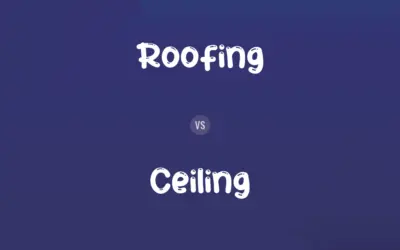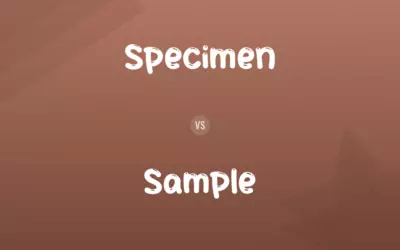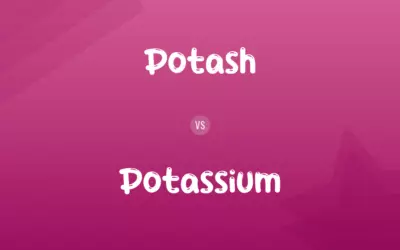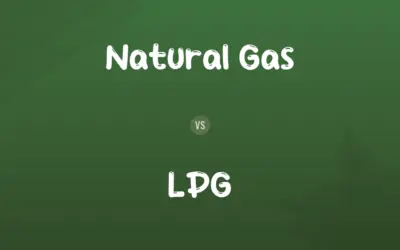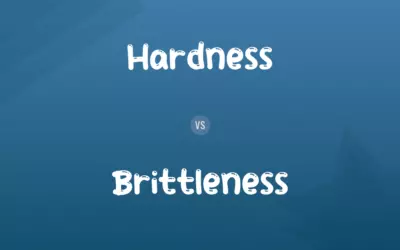Tungsten vs. Titanium: Difference and Comparison
Edited by Muazma Batool — By Muneeza Rehman — Published on March 31, 2024
Tungsten is known for its high density and melting point, making it ideal for applications requiring heat resistance. Titanium is renowned for its strength-to-weight ratio and corrosion resistance, making it suitable for aerospace and medical implants.
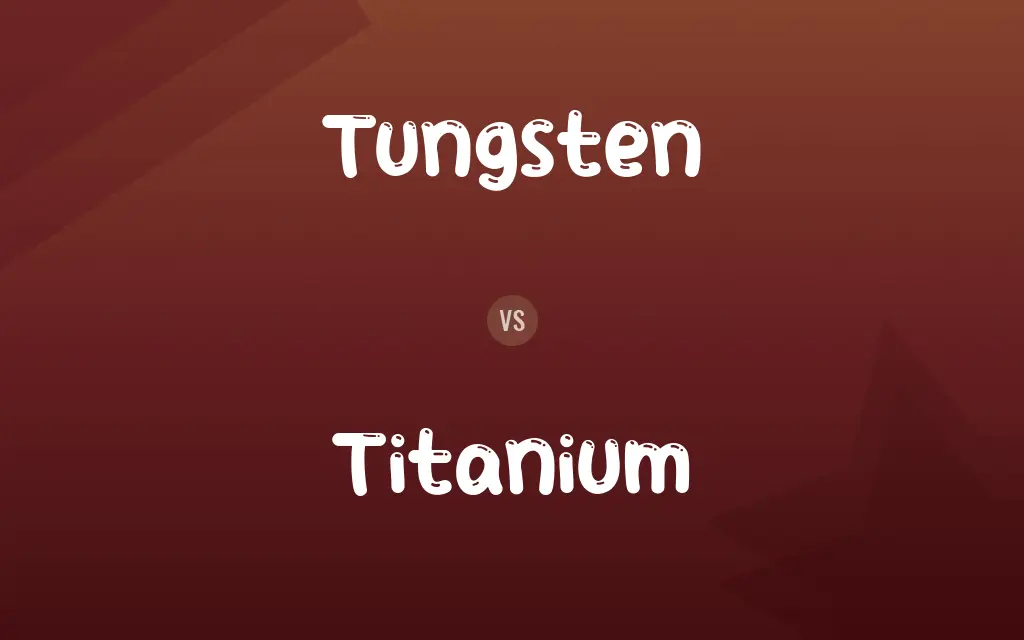
Difference Between Tungsten and Titanium
Tungsten, with the highest melting point of all metals and remarkable density, is extensively used in electrical and military applications, including light bulb filaments and projectiles. Its significant hardness and brittleness under certain conditions make it less suitable for applications requiring substantial material flexibility or deformation. Titanium is distinguished by its exceptional corrosion resistance, excellent strength-to-weight ratio, and biocompatibility, which make it invaluable in aerospace, biomedical implants, and marine applications. Though not as hard as tungsten, its alloyed form significantly increases its strength without substantially adding weight, offering a unique blend of durability and lightweight properties.
Muneeza Rehman
Mar 31, 2024
The choice between tungsten and titanium depends on the specific application requirements: tungsten is preferred for its thermal stability and high density in applications like radiation shielding and high-temperature environments, whereas titanium is chosen for applications demanding high strength, lightweight, and resistance to corrosion, such as aircraft construction and human implants.
Muneeza Rehman
Mar 31, 2024
From an economic standpoint, titanium is generally more expensive than tungsten due to its complex extraction and processing methods, despite tungsten's rarity. The cost factor, combined with material properties, plays a crucial role in determining their use in various industries.
Muneeza Rehman
Mar 31, 2024
Environmental and health considerations also differ; tungsten's impact is primarily industrial, requiring careful handling due to its heavy metal properties, especially in powder form. Titanium, recognized for its biocompatibility, has a more direct impact on human health applications but requires energy-intensive production processes that have a significant environmental footprint.
Nolan
Mar 31, 2024
Tungsten vs. Titanium Comparison Chart
Melting Point
Highest of all metals (~3422°C)
High, but lower than tungsten (~1668°C)
Muneeza Rehman
Mar 31, 2024
Density
Very high (~19.25 g/cm³)
Lower (~4.5 g/cm³), advantageous for lightweight applications
Muneeza Rehman
Mar 31, 2024
Strength
Extremely hard, but brittle
High strength-to-weight ratio, strong when alloyed
Muneeza Rehman
Mar 31, 2024
Corrosion Resistance
Good, but varies with conditions
Excellent, including resistance to sea water and chlorine
Henry
Mar 31, 2024
Applications
Light bulb filaments, cutting tools, and military applications
Aerospace, medical implants, and marine hardware
Lucas
Mar 31, 2024
Environmental Impact
Industrial handling concerns, especially in powder form
Energy-intensive production, but recyclable
Muneeza Rehman
Mar 31, 2024
Health Impact
Considerations for industrial exposure
Biocompatible, widely used in medical implants
Muneeza Rehman
Mar 31, 2024
Tungsten vs. Titanium Definitions
◉Tungsten
A dense metal with the highest melting point.
Tungsten is used in light bulb filaments for its high melting point.
Lucas
Feb 27, 2024
◉Titanium
Known for its strength-to-weight ratio and corrosion resistance.
Titanium frames are used in high-performance bicycles for lightweight durability.
Leo
Feb 27, 2024
◉Tungsten
Can be brittle in certain conditions.
Despite its hardness, tungsten can crack under high impact.
Muneeza Rehman
Feb 27, 2024
◉Titanium
Biocompatible, making it ideal for medical implants.
Titanium is the material of choice for hip and knee replacements.
Olivia
Feb 27, 2024
◉Tungsten
Used in military applications for its density.
Tungsten is utilized in projectiles for its ability to penetrate armor.
Jonathan
Feb 27, 2024
◉Titanium
Resistant to sea water and chlorine.
Titanium is used in marine applications to resist corrosion.
Muneeza Rehman
Feb 27, 2024
◉Tungsten
Industrial applications must manage its heavy metal properties.
Tungsten powder handling requires safety precautions to avoid inhalation.
Levi
Feb 27, 2024
◉Titanium
Widely used in aerospace for its lightweight and strength.
Aircraft engines utilize titanium alloys to reduce weight without compromising strength.
Muneeza Rehman
Feb 27, 2024
◉Tungsten
Primarily used where high density and heat resistance are needed.
Tungsten alloys are preferred for aerospace heat shields.
Jonathan
Feb 27, 2024
◉Titanium
More expensive due to its complex processing.
The high cost of titanium is attributed to its Kroll process extraction and refinement.
Muneeza Rehman
Feb 27, 2024
◉Tungsten
A hard, brittle, corrosion-resistant, gray to white metallic element extracted from wolframite, scheelite, and other minerals, having the highest melting point and lowest vapor pressure of any metal. Tungsten and its alloys are used in high-temperature structural materials and wear-resistant tools and machine parts; in electrical elements, notably lamp filaments; and in instruments requiring thermally compatible glass-to-metal seals. Atomic number 74; atomic weight 183.84; melting point 3,422°C; boiling point 5,555°C; specific gravity 19.3 (20°C); valence 2, 3, 4, 5, 6. Also called wolfram. See Periodic Table.
Muneeza Rehman
Feb 27, 2024
◉Titanium
A strong, low-density, highly corrosion-resistant, lustrous white metallic element that occurs widely in igneous rocks and is used to alloy aircraft metals for low weight, strength, and high-temperature stability. Atomic number 22; atomic weight 47.87; melting point 1,668°C; boiling point 3,287°C; specific gravity 4.51; valence 2, 3, 4. See Periodic Table.
Muneeza Rehman
Feb 27, 2024
◉Tungsten
A rare metallic chemical element (symbol W, from Latin wolframium) with an atomic number of 74.
Muneeza Rehman
Feb 27, 2024
◉Titanium
A chemical element, atomic number 22; it is a strong, corrosion-resistant transition metal, used to make light alloys for aircraft etc.
Muneeza Rehman
Feb 27, 2024
◉Titanium
An elementary substance found combined in the minerals manaccanite, rutile, sphene, etc., and isolated as an infusible iron-gray amorphous powder, having a metallic luster. It burns when heated in the air. Symbol Ti. Atomic weight 48.1.
Muneeza Rehman
Feb 27, 2024
◉Tungsten
A rare element of the chromium group found in certain minerals, as wolfram and scheelite, and isolated as a heavy steel-gray metal which is very hard and infusible. It has both acid and basic properties. When alloyed in small quantities with steel, it greatly increases its hardness. Symbol W (Wolframium). Atomic weight, 183.6. Specific gravity, 18.
Elijah
Feb 27, 2024
◉Titanium
A light strong gray lustrous corrosion-resistant metallic element used in strong light-weight alloys (as for airplane parts); the main sources are rutile and ilmenite
Henry
Feb 27, 2024
◉Tungsten
A heavy gray-white metallic element; the pure form is used mainly in electrical applications; it is found in several ores including wolframite and scheelite
Muneeza Rehman
Feb 27, 2024
Tungsten vs. Titanium Frequently Asked Questions
Why is tungsten used in light bulb filaments?
Tungsten is used for its high melting point, allowing it to glow brightly without melting.
Muneeza Rehman
Mar 31, 2024
Are tungsten and titanium recyclable?
Yes, both metals are recyclable, with titanium recycling being particularly important due to its high value and environmental impact of production.
William
Mar 31, 2024
Can titanium replace tungsten in high-temperature applications?
While titanium has a high melting point, tungsten's superior temperature tolerance makes it irreplaceable in the highest temperature applications.
Muneeza Rehman
Mar 31, 2024
Can tungsten and titanium be alloyed together?
Yes, they can be alloyed for specific applications requiring both high strength and temperature resistance, though such use is specialized.
Muneeza Rehman
Mar 31, 2024
Is titanium or tungsten better for jewelry?
Titanium is preferred for lightweight and hypoallergenic jewelry, while tungsten is chosen for its weight and scratch resistance.
Muneeza Rehman
Mar 31, 2024
What are the environmental impacts of mining tungsten and titanium?
Mining both metals has significant environmental impacts, including habitat destruction and pollution, though titanium's production is notably more energy-intensive.
Henry
Mar 31, 2024
How are tungsten and titanium extracted and processed?
Tungsten is extracted from ore and refined through a series of chemical processes, while titanium extraction involves the Kroll process, which is more complex and costly.
William
Mar 31, 2024
How do the health impacts of tungsten and titanium differ?
Tungsten's health impacts are primarily industrial, related to inhalation of its powders, while titanium is notable for its biocompatibility and use in medical implants.
Olivia
Mar 31, 2024
Why is titanium used in aerospace applications?
Its high strength-to-weight ratio and corrosion resistance make titanium ideal for aerospace, reducing aircraft weight and increasing fuel efficiency.
William
Mar 31, 2024
What makes titanium resistant to corrosion?
Titanium's corrosion resistance is due to a stable, protective oxide layer that forms on its surface when exposed to air, effectively preventing further degradation by most acids, chlorides, and seawater.
Nolan
Mar 31, 2024
How does the weight of tungsten compare to titanium for similar applications?
Tungsten is significantly heavier than titanium, making tungsten more suitable for applications where weight is beneficial, such as in counterweights or vibration dampening systems, whereas titanium is preferred for applications where lightness is crucial, like in aerospace structures.
Leo
Mar 31, 2024
Content Creators
Written by
Muneeza RehmanAt Comparisons.wiki, Muneeza skillfully navigates the vast sea of information, ensuring clarity and accuracy as the lead content editor. With a keen eye for detail, she curates every comparison to enlighten and engage readers.
Edited by
Muazma BatoolAs a content editor, Muazma Batool is not just a grammar guru but a creative mastermind who breathes life into every word. With an eagle eye for detail and a passion for storytelling, she transforms bland text into engaging content that captivates audiences and drives results.


